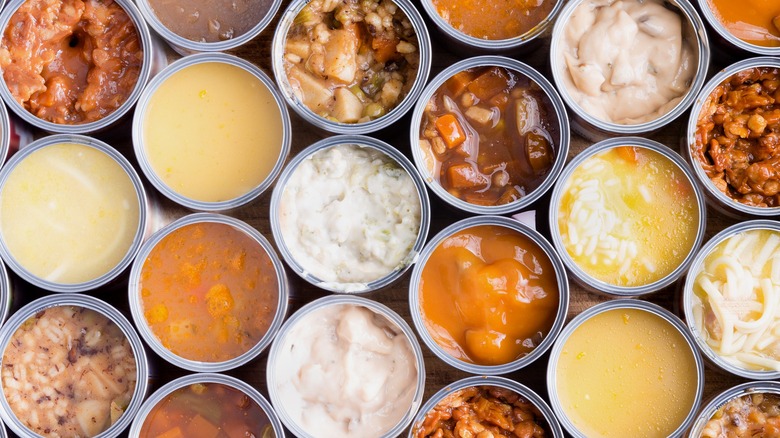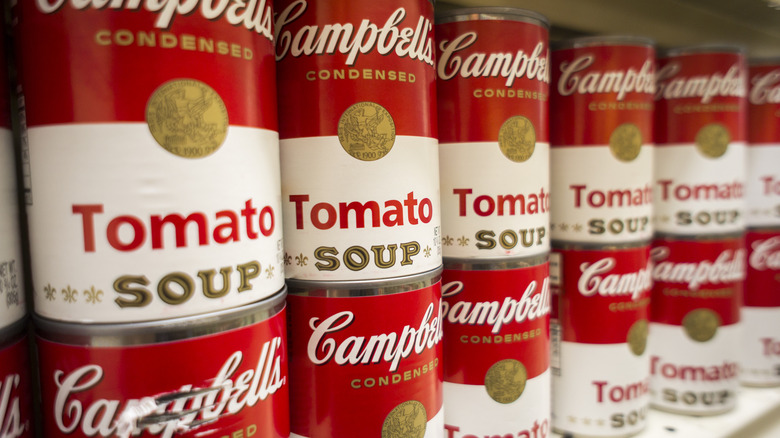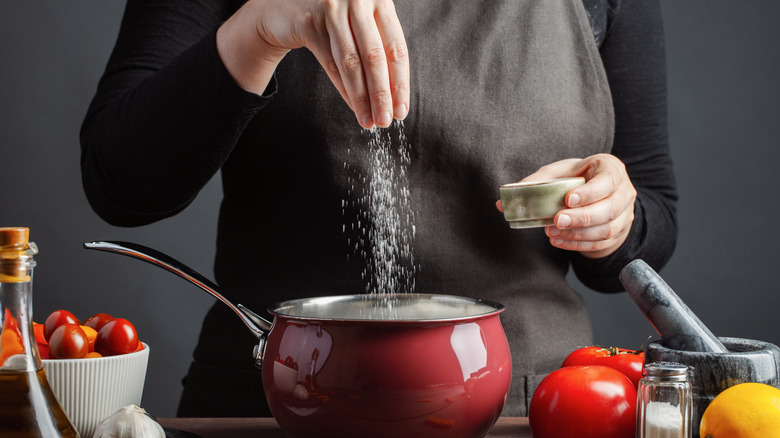Why Is Canned Soup So Salty?
Even if you're aware of the notoriously high salt levels in canned soups, you still might be taken aback when you check the labels in the soup aisle. Take the humble Campbell's Cream of Chicken soup, a beloved addition to casseroles across the Midwest and beyond, which contains 870 milligrams of sodium per half-cup portion.
To put that number in perspective, that's about 38% of the recommended daily maximum for sodium of 2,300 milligrams. That wouldn't be a huge deal if you didn't eat many other salty foods, but accomplishing such a low-sodium day would be quite difficult. High-salt foods like canned soups, bread, cheese, and cured meats like ham put the average American roughly 50% over their target with the average person taking in 3,393 milligrams of sodium per day.
While sodium is an essential nutrient for regulating fluid balance and the function of nerves and muscles, it's possible to have too much of a good thing. Too much salt can lead to minor issues like bloating, increased blood pressure (which affects nearly 50% of Americans according to the CDC), and more serious problems like heart and kidney disease. With this in mind, you may wonder why soup companies are still making their products so salty. It turns out that the reason has little to do with preservation and a lot to do with our tastebuds.
Boiling down why canned soup is high in sodium
Salt has been used to preserve food for thousands of years, and this is still true for some processed foods like canned soup. As is the case with pickling, salt prevents spoilage by making an unfriendly environment for bacteria. However, salt isn't the only way to preserve food. Canned foods also undergo a heating process that kills potential pathogens. Food producers often use multiple methods, including heating, salt, and other preservatives. The more methods they use, the harder it is for bacteria to grow.
It's possible to make safe soups and other canned goods without excessive salt, but brands are still doing it. That's because salt isn't just a preservative, it enhances taste — and people love the taste of salt. According to research published in the journal Chemosensory Perception, salt intake and preference work in a positive feedback loop, where people on higher salt diets tend to prefer higher salt foods as their sensitivity to it dulls over time. In that sense, our tastebuds inform what appears on grocery store shelves.
Shopping the soup aisle the smart way
The good news? You don't need to give up canned soup to be healthy, and there are some tried-and-true methods for navigating the grocery aisles and your kitchen with confidence. Start by looking closely at the front and back of your soup label — your favorites might be higher in sodium than you think.
For instance, the front label of Amy's Organic Tortilla soup may look wholesome, but the nutrition facts panel shows a one-cup serving has 870 milligrams of sodium. Campbell's Chunky Clam Chowder is another good example — one cup has 840 milligrams of sodium, but if you ate the whole can (as most would), that's 1820 milligrams. This is why it's important to consider the serving size and the portion size you'll be eating.
If you know what to look for, there are tons of quality canned soups that are low in salt. Percent daily values can help, with 5% or less generally being low and 20% or more being high. To bear a low sodium label, a food should have 140 milligrams of sodium or less per serving. Foods labeled reduced sodium have 25% less sodium than a comparable version, which may still be salty. You can also slash the sodium content of your soup by diluting it with a low-sodium broth or adding vegetables to the mix. As an alternative, whipping up a homemade soup (like hearty ribollita soup) puts you in full control of the salt.


